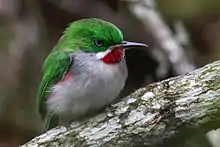Narrow-billed tody
The narrow-billed tody (Todus angustirostris) is a species of bird in the Todidae family, and one of two Todus species found on Hispaniola (split between Haiti and the Dominican Republic), along with the broad-billed tody (Todus subulatus), where it is endemic. Its natural habitats are subtropical or tropical moist montane forests and heavily degraded former forest.
| Narrow-billed tody | |
|---|---|
 | |
| Scientific classification | |
| Kingdom: | Animalia |
| Phylum: | Chordata |
| Class: | Aves |
| Order: | Coraciiformes |
| Family: | Todidae |
| Genus: | Todus |
| Species: | T. angustirostris |
| Binomial name | |
| Todus angustirostris Lafresnaye, 1851 | |
Taxonomy and systematics
The broad-billed tody belongs to the genus Todus, of the family Todidae, the suborder Alcedines, order Coraciiformes and class Aves. Originally, it was thought that broad- and narrow-billed todies shared a common ancestor and then split into two species, as they are the only tody species that share an island. However, mitochondrial DNA analysis has shown that the broad-billed tody descended from the Puerto Rican tody, while the narrow-billed tody descended from the Cuban tody, which was native to the island first. The ancestors of the broad-billed tody migrated to the island two to three million years ago, meaning they have always been distinct species.There has also been a question about where to place the family Todidae among other taxonomic groups, due to their similarities with other birds, such as the nightjars (Caprimulgidae), the trogons (Trogonidae), the puffbirds (Bucconidae), among others. In 1790, the genus Todus was established, to separate the todies from the kingfishers of genus Alcedo, with the order "Todiformes" being proposed in 1882 but rejected. Currently, in combination with DNA, geographical and evolutionary analysis, it is firmly believed that todies belong to the order Coraciiformes.
References
| Wikimedia Commons has media related to Todus angustirostris. |
- BirdLife International (2012). "Todus angustirostris". IUCN Red List of Threatened Species. 2012. Retrieved 26 November 2013.CS1 maint: ref=harv (link)
